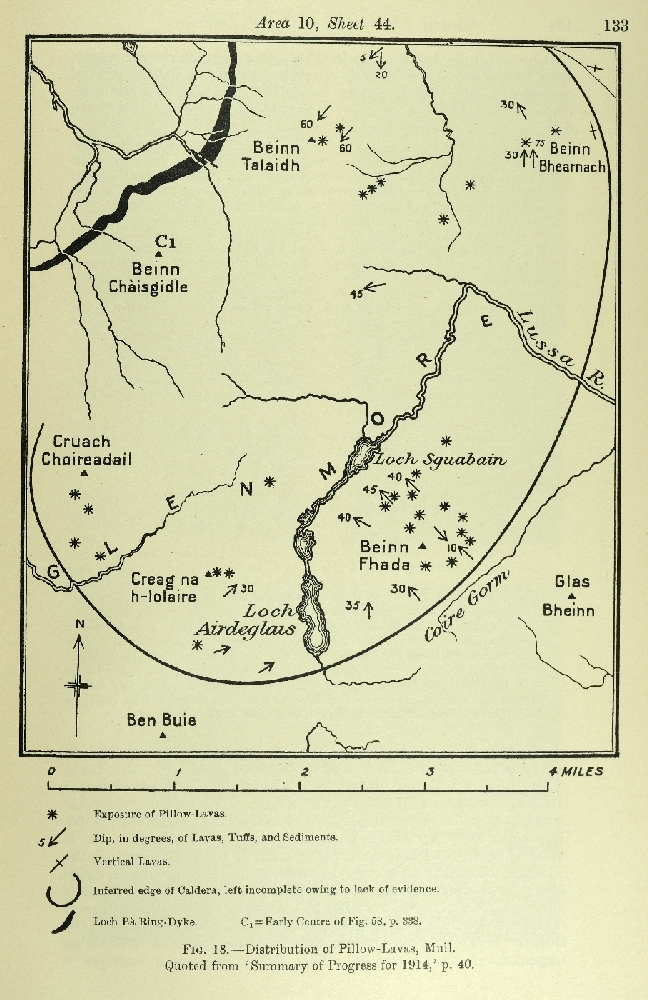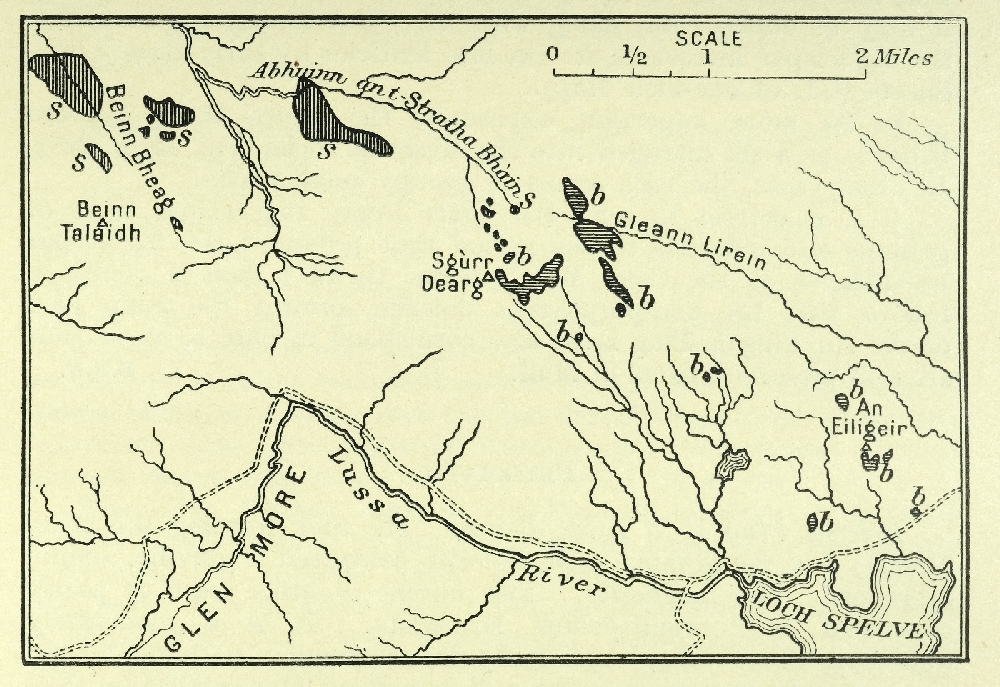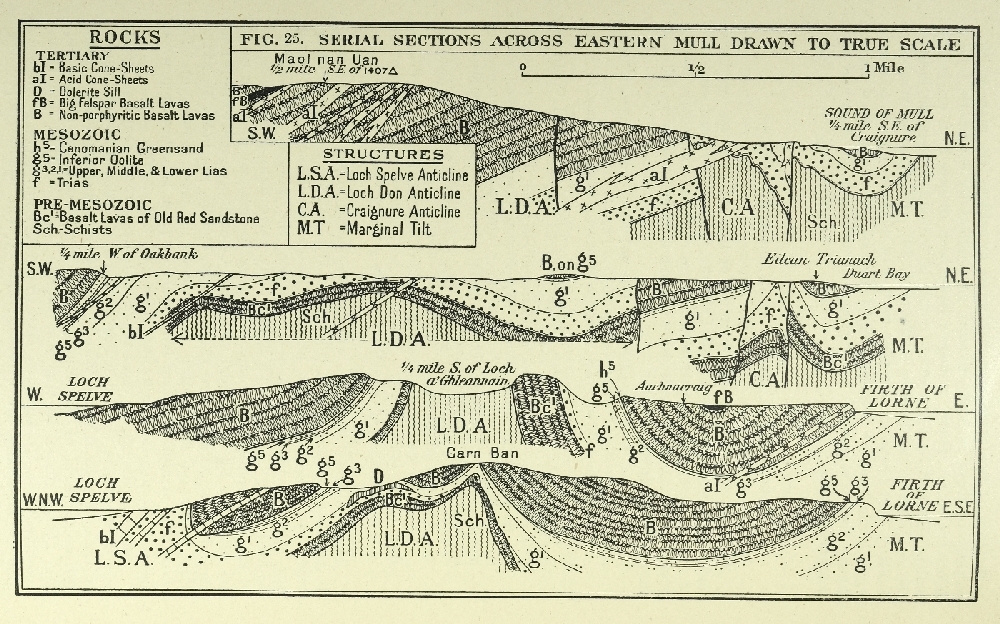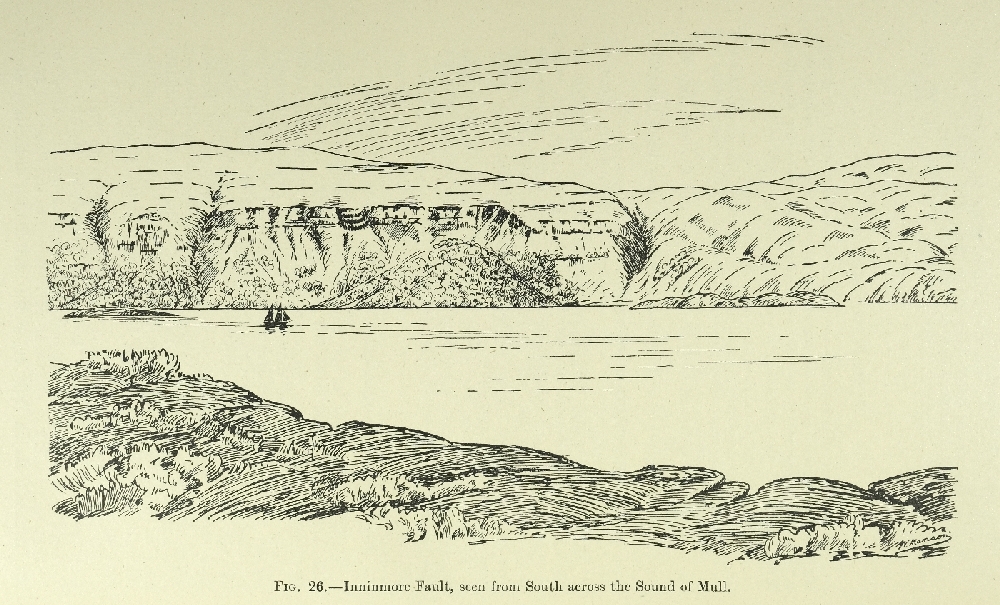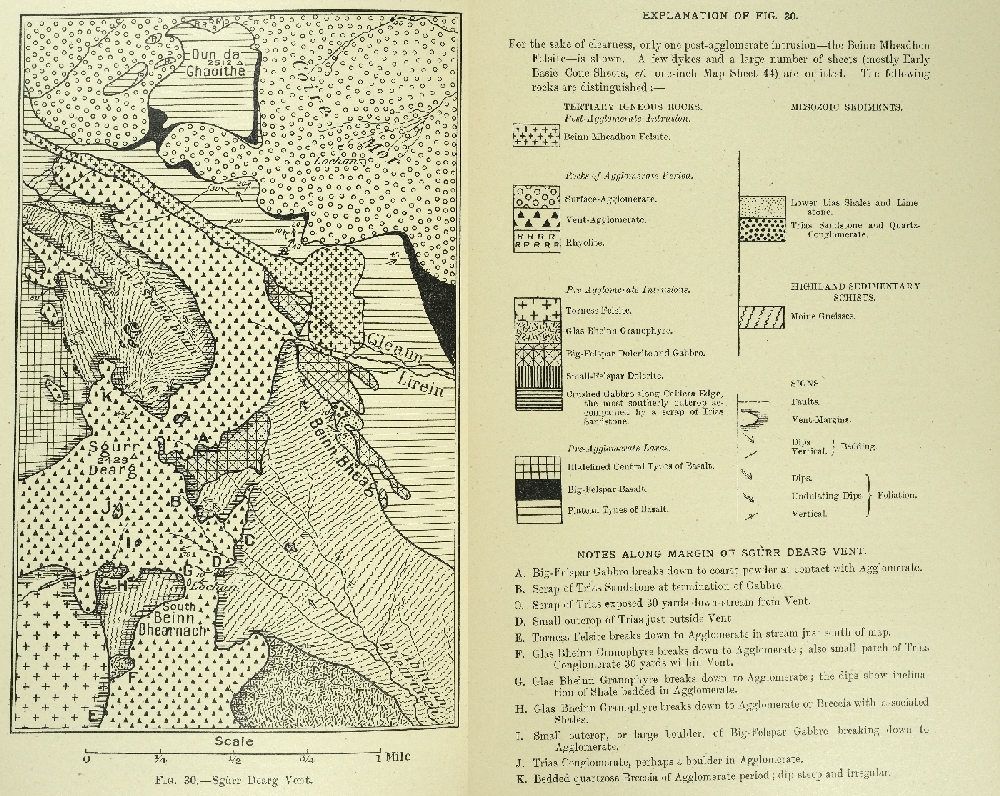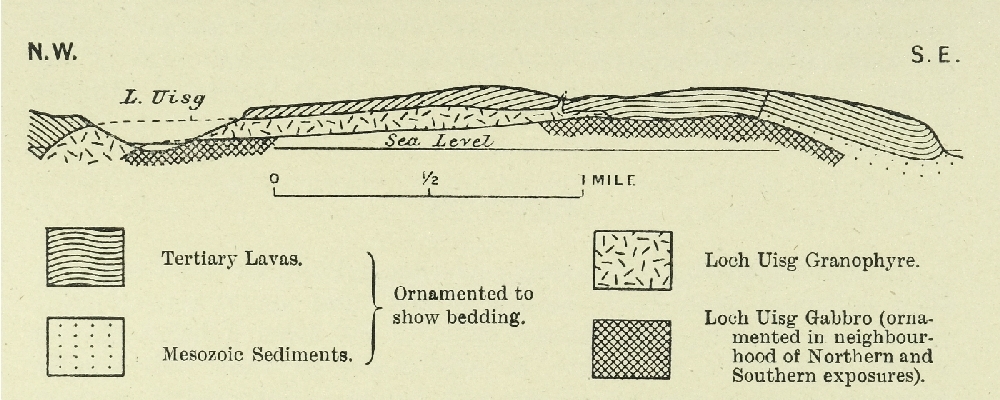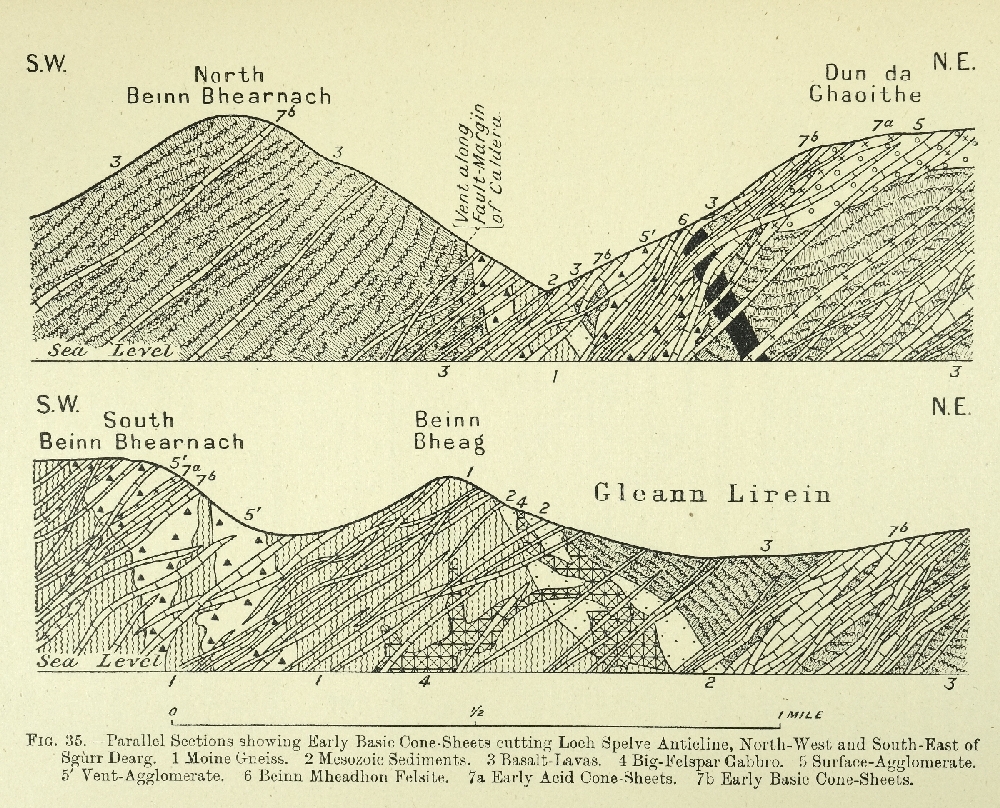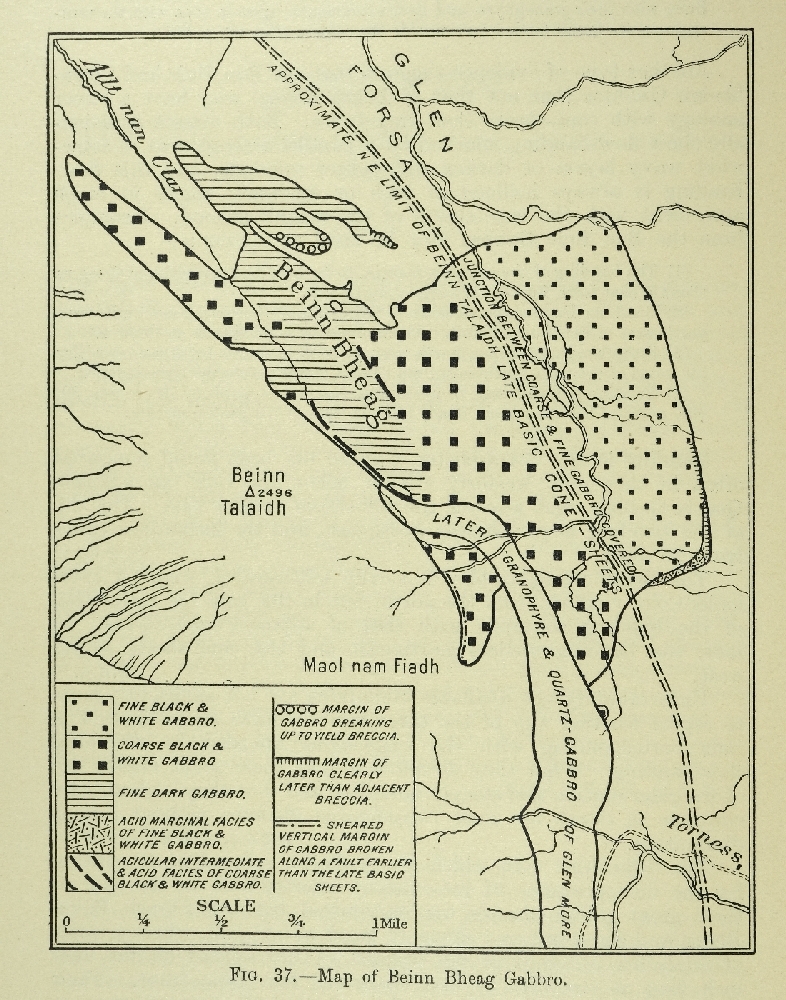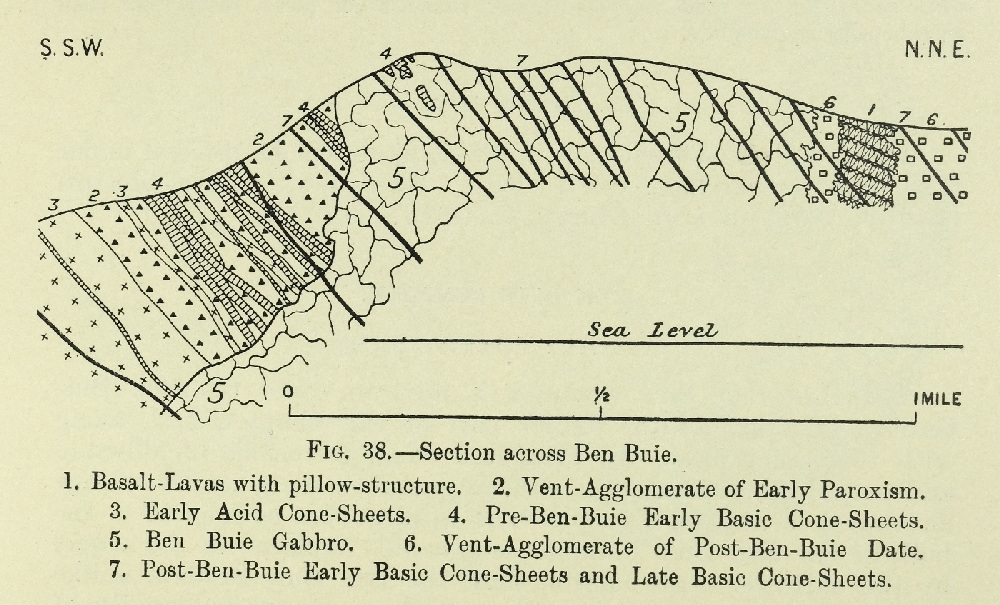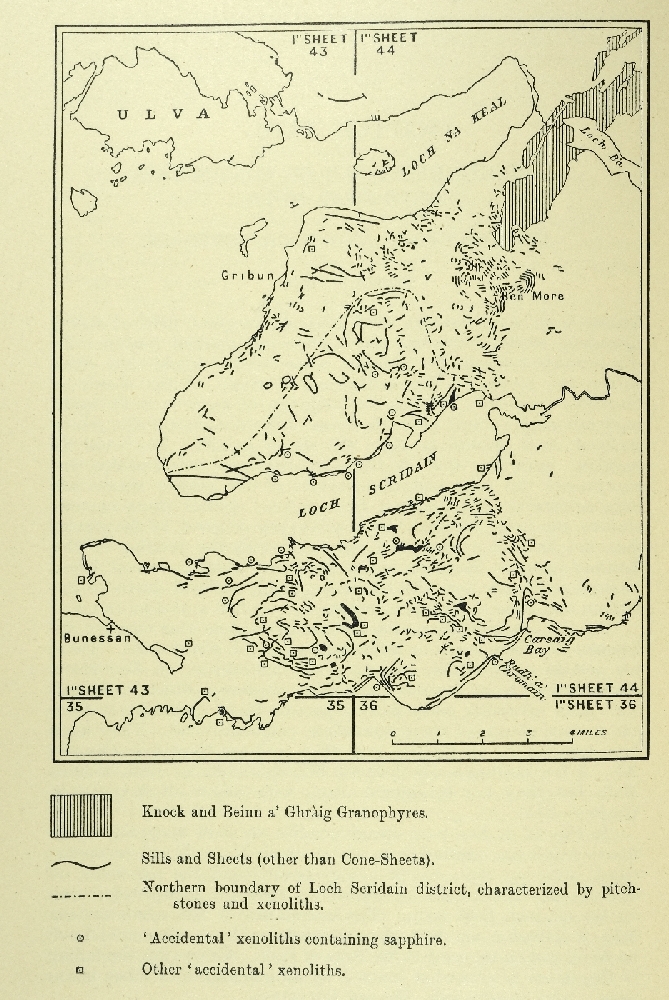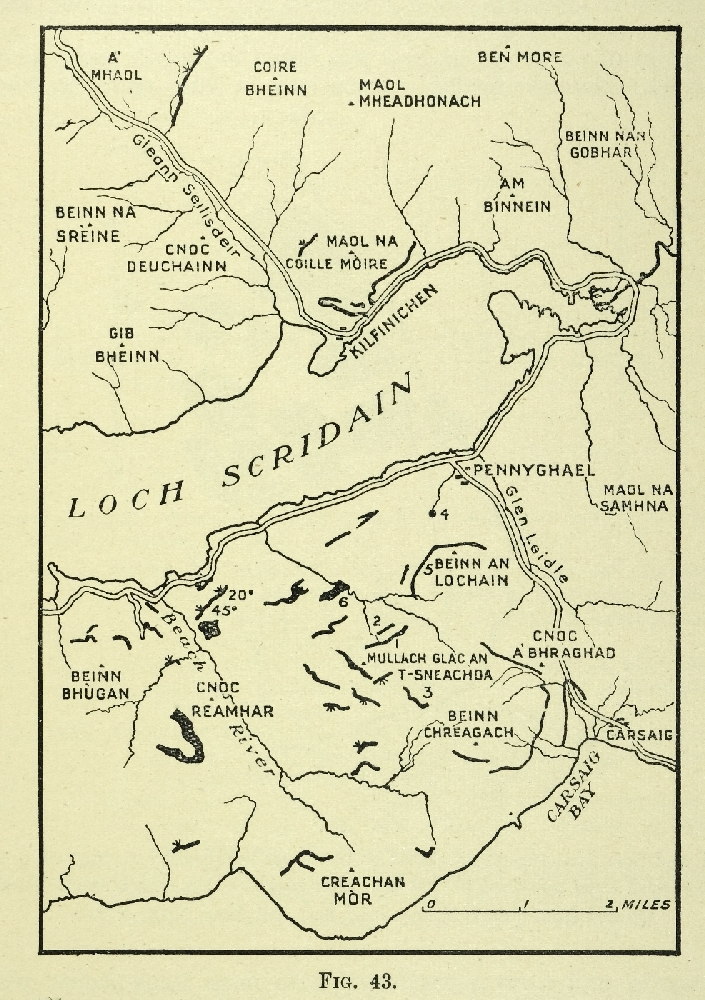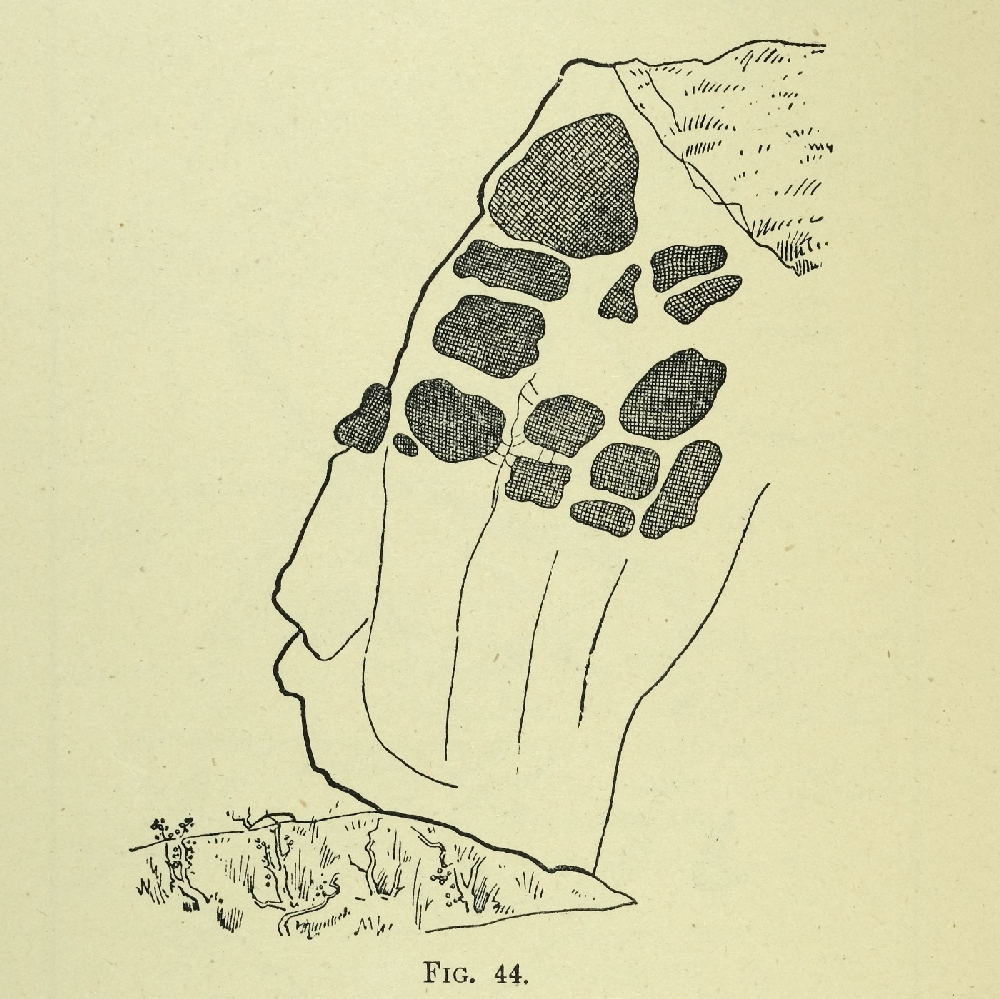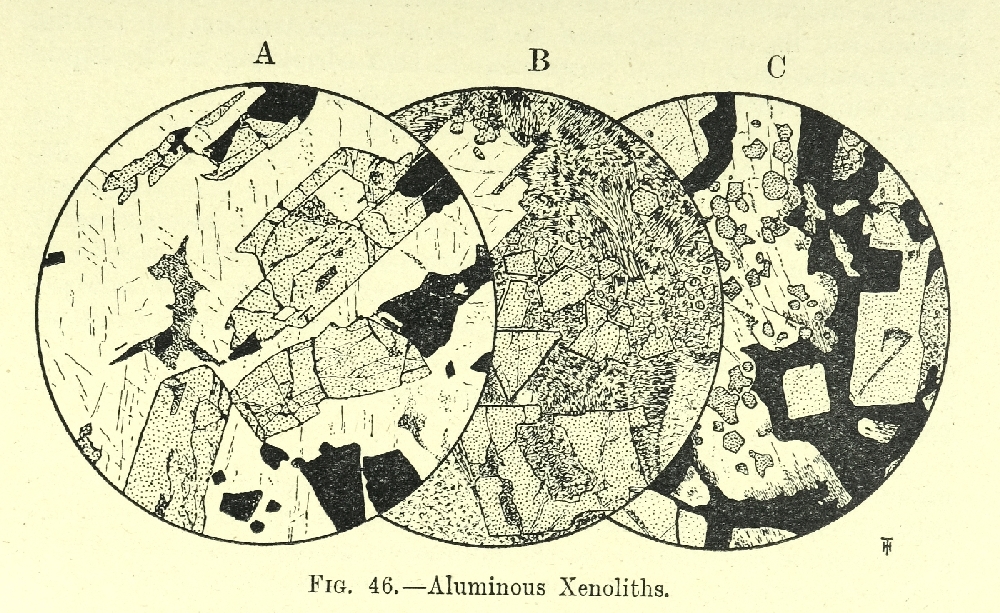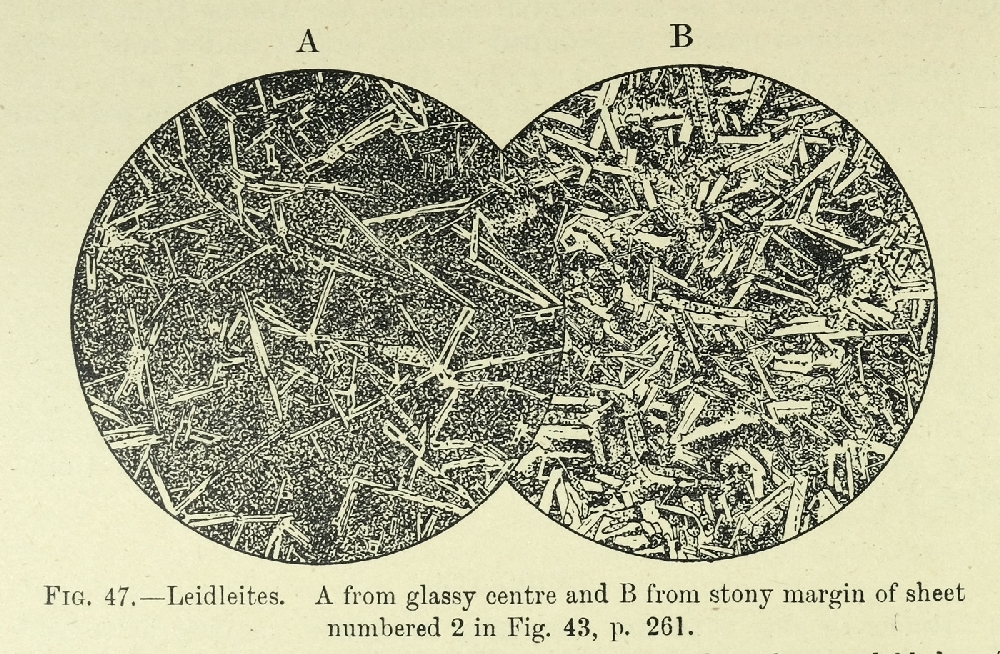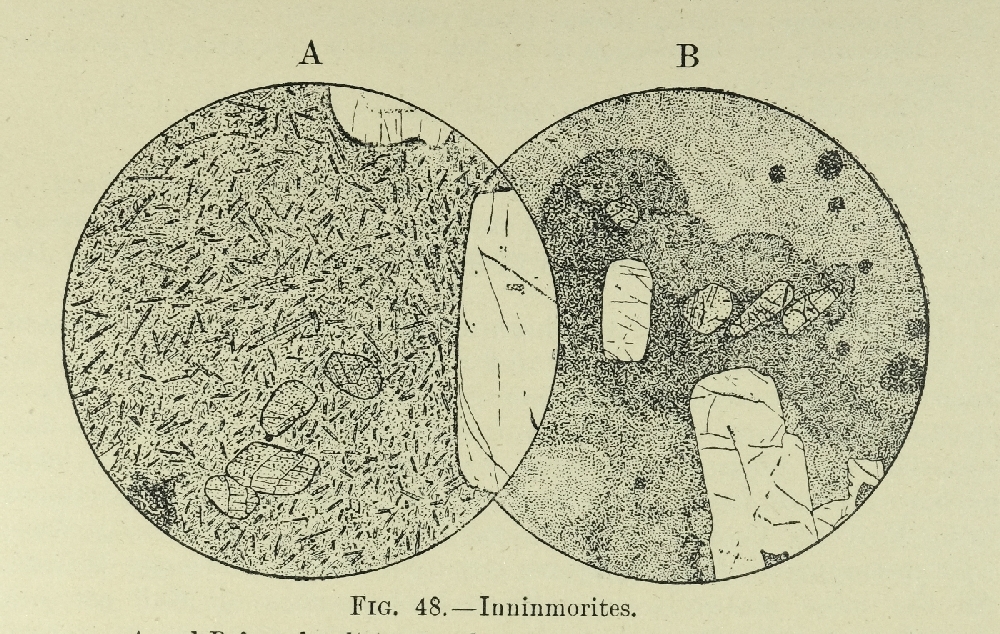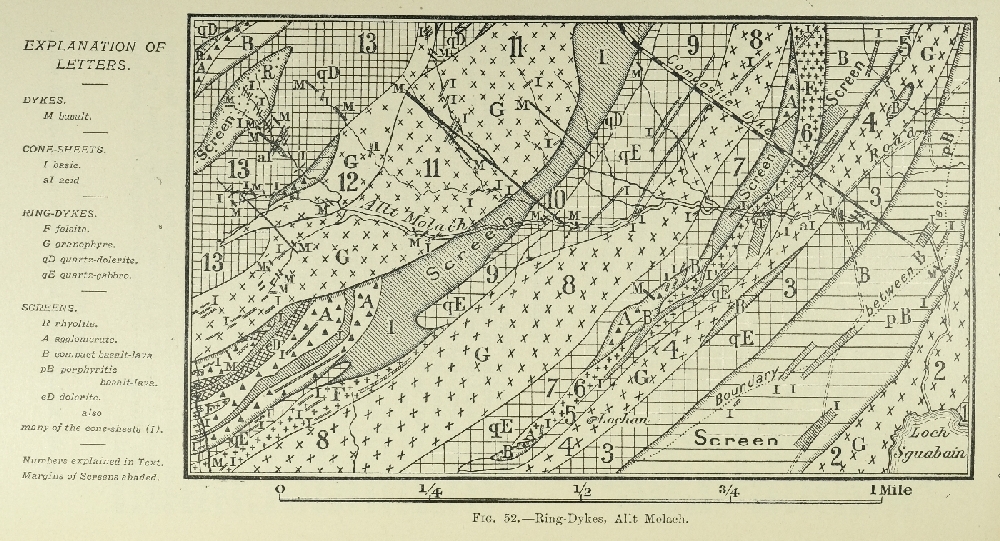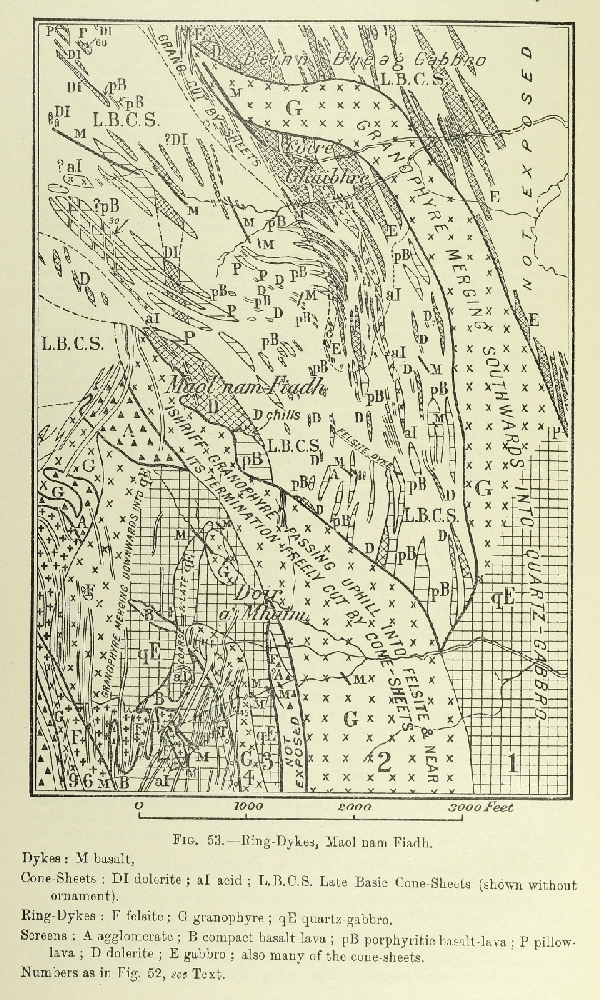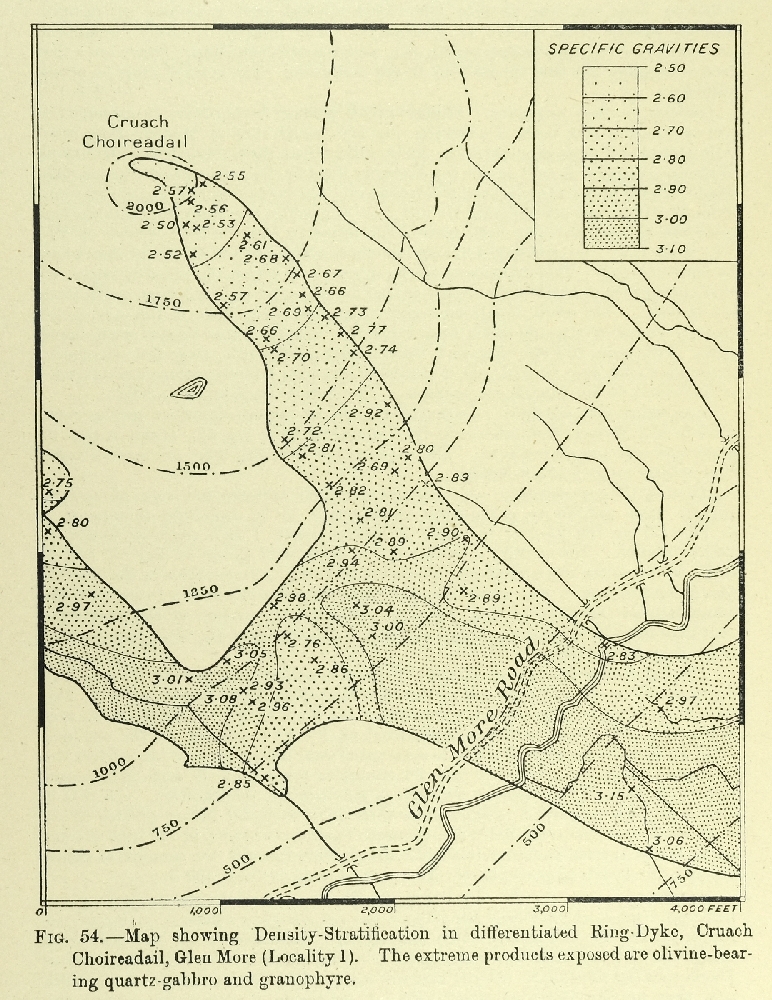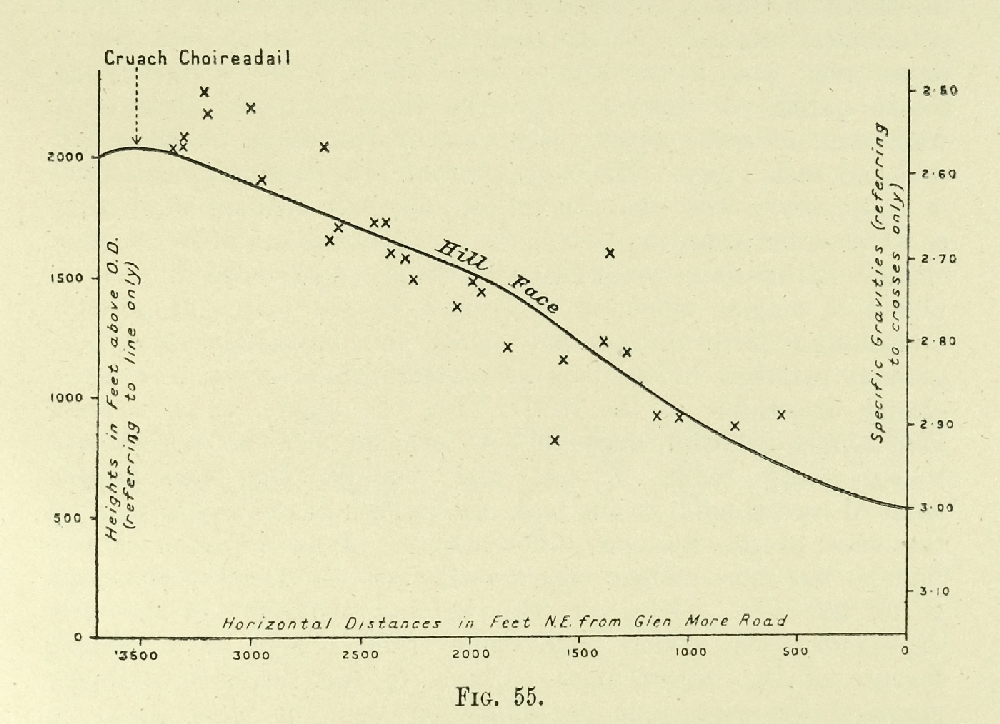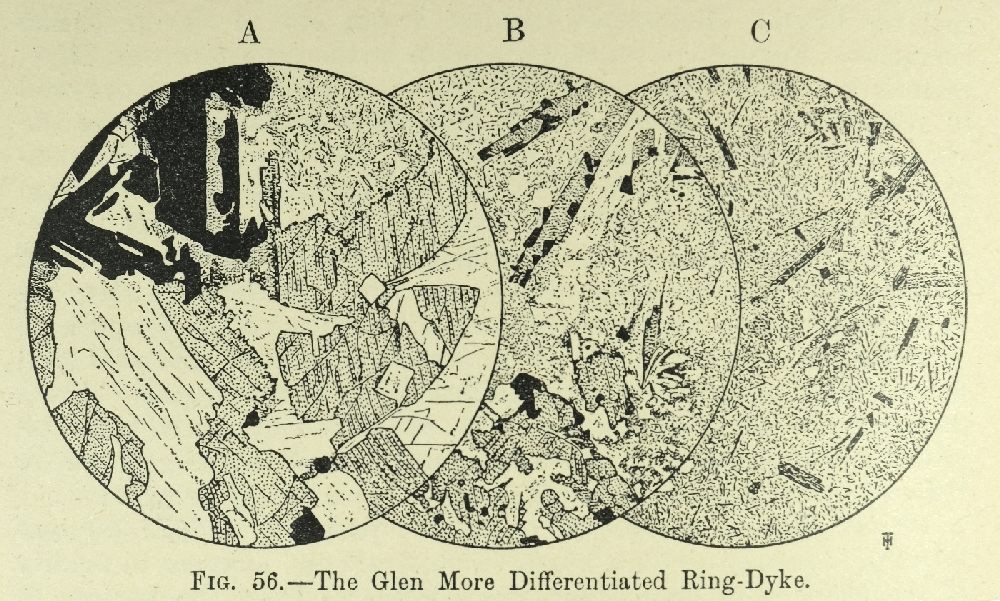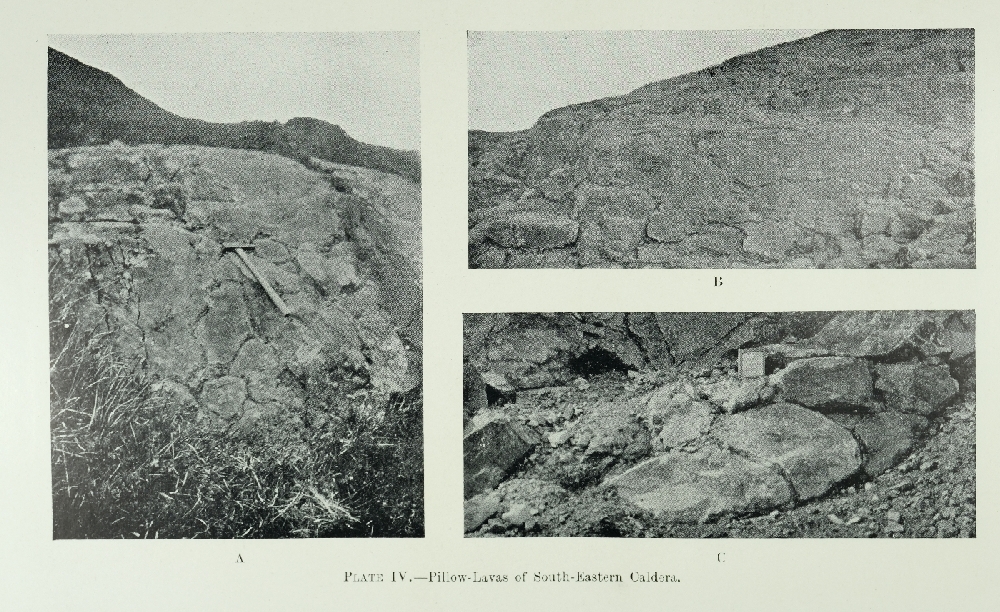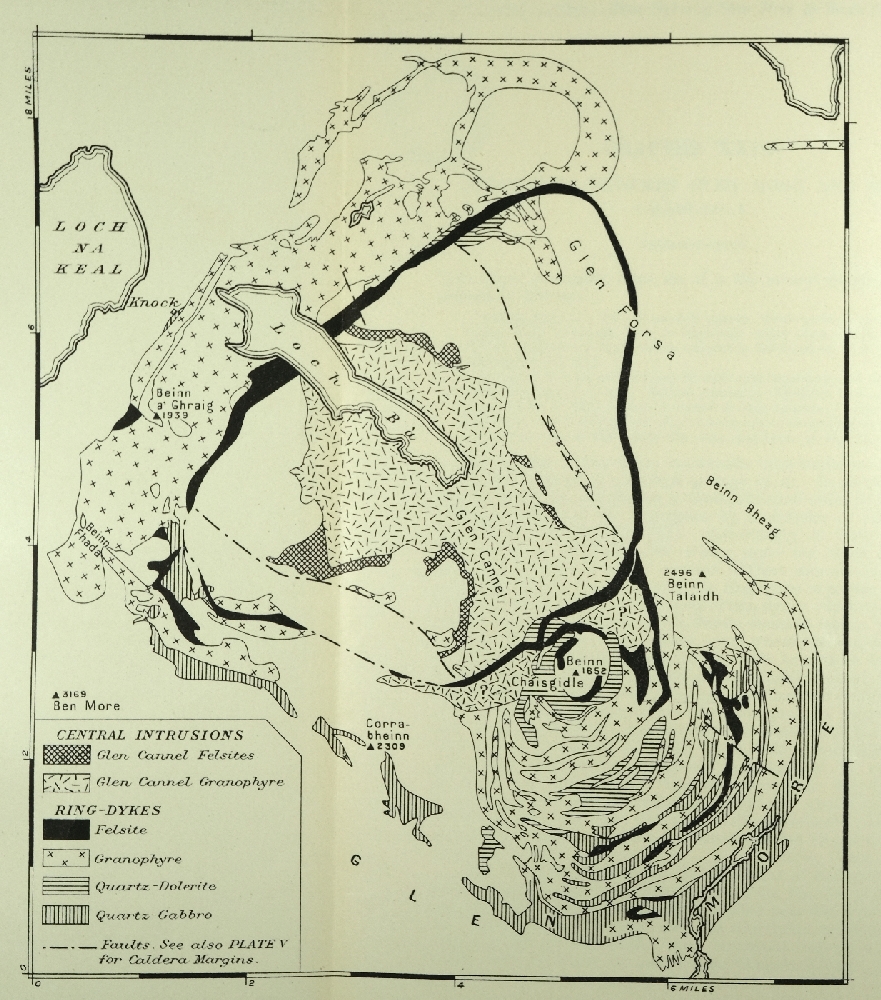Itinerary
Geological visitors to Mull must be prepared for bad weather, and also for difficulty in obtaining quarters. The average annual rainfall at Gleneartnel, in the centre of the mountains (Sheet 44), is about 117 inches; at Gruline, near the mouth of Loch Bà. (Sheet 44), 79 inches; at Ulva, near the mouth of Loch na Keal (Sheet 43), 65 inches; at Quinish, in northern Mull (Sheet 52), 56 inches; at Oban, on the mainland east of Mull (Sheet 44), 53 inches; and at Iona, west of Mull (Sheet 43), 47 inches.
May falls in the centre of a comparatively dry period; and, with June, has the further advantage of being a rather easy month in which to obtain accommodation. On the other hand, travelling facilities are better in the tourist-season, roughly speaking July and August, when it is possible, for instance, to visit Staffa by steamer.
The regular ports of call in Mull and district are Craignure, Lochaline (Morven), Salen, Croggan, and Carsaig, all in Sheet 44; Iona Ferry, Bunessan and Staffa, Sheet 43; and Tobermory, Sheet 52. Most of the roads, with the exception of the Glen More road connecting Loch Spleve and Loch Scridain, are traversed by postal gigs or motors on steamer-days.
The mountainous district, where the complicated geology lies, is largely given over to deer-stalking, and strangers are not welcome off the beaten track during August and September.
There are but few hotels or inns, but on the other hand there are several farms or cottages ready to take in one or two visitors if arrangements are made in advance. In the following statement all that is attempted is a brief summary of the geological features that can be reached on foot, or with the help of a bicycle, from the main centres of population. If a party of geologists plans an excursion to the island, they will be well-advised to take a tent, and camp alongside conveniently situated houses.
Sheet 44
Salen is taken first in this itinerary as the main village within Sheet 44. Other places are dealt with in clockwise rotation.
Salen—Village with Hotel
(a) Sound of Mull, east to Carmony Point: contrast of Lavas of Area 9 (Chapter 8), lying inside Pneumatolysis Limit of
(b) Hills between Sound of Mull and Glen Forsa: Agglomerate-Vents (p. 206); Beinn Mheadhon Felsite (Chapter 17); Early Acid and Basic Cone-Sheets (Chapters 19 and 21).
(c) Glen Forsa: Fan and eskers (Chapter 37); Killbeg Bing-Dyke (p. 343); Loch Bà Felsite Ring-Dyke and faulting of Early Basic Cone-Sheets (pp. 339, 238); Gaodhail River section of Augite-Diorite and Late Basic Cone-Sheets (Chapters 18 and 28).
(d) Loch Bà: Knock and Beinn a' Ghràig Granophyres separated by Screen; Caps on Beinn Ghràig Granophyre; Late Basic Cone-Sheets cut by Granophyre; Loch Bà Felsite Ring-Dyke—all in Chapter 32 (
(e) Ben More Massif: Amygdaloidal lavas of Pneumatolytic Zone both without and within Contact-Alteration Zone (pp. 128, 142, 152); Ben More Mugearite (Chapter 8); Sills (Chapter 26).
(f) Loch na Keal, South Shore; Contrast of Lavas of Area 8 (Chapter 8), inside Pneumatolysis Limit, and those Area 2 (Chapter 6), outside same; Sills (Chapter 26); Dykes, altered within Pneumatolysis Limit (Chapter 34); Glaciated Pot-Holes (Chapter 37).
(g) Loch na Keal, North Shore: Lavas of Area 3 (Chapter VI); Dykes (Chapter 34).
(h) Sound of Mull, north-westwards Bràigh a' Choire Mhòir trachytic vent (Chapter 14): Lavas of Area 3 (Chapter 6); Dykes (Chapter 34); See also Ardnacross Trachyte of Sheet 52.
Lochaline—Village with Inn (in Morven)
(a) East and west of Loch Aline: Lavas of Area 4 (Chapter 6); Dykes (Chapter 34).
(b) West of Loch Aline: Inninmore Fault (
Craiguure—Hamlet with Inn.
(a) Sound of Mull, south-east to Duart Bay: Craignure Anticline and Early Acid Cone-Sheets (Chapters 13 & 19).
(b) Dùn da Ghaoithe Range: Big-Felspar and other Basalt-Lavas of Area 5 (Chapter 8); Agglomerates of Coire Her Syncline (Chapter 15); Early Acid and Basic Cone-Sheets (Chapters 19 & 21).
(c) Sound of Mull north-west to Garmony Point: Craignure Anticline (p. 176). Composite Cone-Sheets (pp. 223, 228).
Lochdonhead—Village
(a) North of Loch Don: Sand-Moraine in relation to Raised Beaches (p. 405).
(b) Peninsula south of Loch Don: Lavas of Area 5 (Chapter 8); Marginal Tilt, Duart Bay Syncline, Loch Don Anticline, Coire Mòr Syncline, Loch Spelve Anticline (
(c) Road towards and into Glen More: Roadside sections of Early Basic Cone-Sheets, west of Ardachoil (Chapter 21), and Vent-Agglomerate, opposite Gleann Sleibhte-coire (Chapter 16); Pillow-Lavas, Coire Gorm and Beinn Fhada, and beside track leading to Glen Forsa (
(d) Sgùrr Dearg: Big- and Small-Felspar Dolerites (
(e) Gleann Lìrein Coire Mòr Syncline and Beinn Mheadhon Felsite (
Oban, Kilninver, Clachan Bridge, etc.—Plenty of accommodation (Mainland of Lorne)
Dykes of Mull Swarm (Chapter 34); Explosion-Vents on dykes (pp. 364–5); See also Staffa (Sheet 43).
Croggan—Hamlet
(a) South-east coast to Port a' Ghlinne: Lavas of Area 6 (Chapter 8); Dykes (Chapter 34); Explosion-Vents on Dykes (pp. 365–6).
(b) Inland: Gentle arcuate folds (
Loch Buie—Village
(a) South of Loch Uisg: Lava-succession in Area 6 from Plateau to Central Group (3, Chapters 6 & 8); Arcuate folds cut by Loch Uisg Granophyre (
(b) Kinlochspelve: Barachandroman outcrop of Surface-Agglomerate (pp. 197–8); Moraines of shelly clay (p. 406).
(c) North of Loch Uisg and Loch Spelve and east of Gleann a' Chaiginn Mhòir: Relation of Ben Buie Gabbro to Early Basic Cone-Sheets (Chapter 21); Agglomerate-Vents (p. 207); Glas Bheinn Granophyre and its assimilation of sandstone (Chapter 12); moraines (p. 399).
(d) North of Loch Buie: Ben Buie Gabbro (
(e) West of Loch Buie: Lava-succession in Area 7 from Plateau to Central Group (
Carsaig —A few houses
Desert-Sandstone (p. 57); Lavas of Area 1 with examples of double-tier Columnar
Kinlochscridairt—Inn
(a) Westwards both sides of Loch Scridain: Lavas of Areas 7 and 8 (Chapter 8), inside Limit of Pneumatolysis, contrasting with those of Areas 1 and 2 (Chapter 6), outside same; Loch Scridain Sills with pitchstones and xenoliths (
(b) Ben More Massif: see Soden (e).
(c) Glen More road from Inn to Craig Cottage: Mugearite lava (p. 124); Plateau and Central Lavas of Areas 7 and 8 (Chapter 8); Derrynaculen Granophyre (Chapter 12); relations of Early and .Late Basic Cone-Sheets to Ben Buie, Corra-bheinn, and Glen More Gabbros (Chapters 21, 22, 28, 29). Gravitational differentiation (
(d) South-east of Inn: Bostonite (pp. 187–8). See also Loch Buie (c & d).
Glen More
A road runs along the through-valley known as Glen More connecting the north end of Loch Spelve with Kinlochscridain. There are cottages very well situated for the geology at Craig and Ishriff. It may be possible to obtain quarters, or at any rate it is easy to tent at one or other situation. The sections can also be reached by walking, cycling, or driving from Lochdonhead or Kinlochscridain.
(a) Near Craig: See Kinlochscridain (c).
(b) Near Ishriff: Ring-Dykes of
Sheet 43
Bunessan—Village with Hotel
(a) North of Loch Scridain, by boat from one of the coastal cottages: see under Kinlochscridain (a).
(b) South of Loch Scridain: Ardtun Leaf-Beds (Chapters 3 and 4). Prof. Cole's tachylyte-selvage (p. 265). Loch Scridain Sills with pitchstones and xenoliths (Chapters 23–25). Lavas with double-tier columnar jointing (pp. 108, 145).
(c) South and west of village: camptonite-dykes (Chapter 36).
Iona—Village with two hotels. Visitors can reach by motor-boat exposures listed under Bunessan and Staffs.
Staffa—Uninhabited. Visited by Tourist-Steamer from Oban, by sailing-boat from Gometra, or by motor-boat from Iona (Chapter 7).
Ulva and Gometra—Islands with Inn
(a) Staffa, see above.
(b) The islands themselves: Pipe-Amygdales and Segregation-Veins in Lavas (pp. 114, 138); Preglacial Beach-Platform and Sea-Cave (pp. 388, 390).
(c) North of Loch Tuath Pipe-Amygdales and Auto-Intrusion phenomena in Lavas (pp. 113–4); Preglacial Beach-Notch (p. 388).
Gribun. —Village on main road between Salen and Kinlochscridain
Desert-Sand and Silicified Chalk (pp. 54–6). It is possible, though wearisome, to reach Macculloch's Tree, etc., listed under Kinlochscridain (a) by descending cliff near Stac Was Bun an Uisge; Sills (Chapter 23–24); Preglacial Beach-Notch, (p. 387).
Sheet 51
Dervaiy.—Village with Hotel
Lavas (Chapter 7);
Dykes (Chapter 34); Preglacial Beach-Notch (p. 388).
Sheet 52
Tobermory—Village with Hotels.
Ardnacross Trachyte-Plug (p. 186); see also Dervaig (Sheet 51).
E.B.B. (as Editor).

